The massive street protests at last July’s G-8 summit in Genoa, Italy—following similar demonstrations at other international gatherings in Gotenberg, Prague, Washington, Davos, and Seattle—have focused the world’s attention as never before on the phenomenon now known as globalization. The issues raised under the heading of globalization are controversial in part because the term has different meanings for different people. Most broadly, globalization is the expansion and intensification of linkages and flows—of people, goods, capital, ideas, and -cultures—across national borders. To some this process implies the need for an element of global governance—a decline in the importance of national entities as they are replaced by global institutions. A more integrated global system has also increased awareness of a set of common problems—pollution, disease, and crime—that many have come to believe can only be addressed collectively. The result has been growing controversy about how to ensure a safer, more prosperous world to the benefit of all. In this issue of the Brookings Review, experts from inside and outside Brookings address the impact of globalization on a range of international issues.
In some respects, globalization is an old story. Transnational banks and trading enterprises have been important features of international commerce since the Middle Ages in Europe. By some measures, trade between nations was higher at the beginning of the 20th century than at the beginning of the 21st. The gold standard constituted a de facto common monetary system that linked national financial markets more closely than today’s array of floating and semi-floating exchange rates. The movement of people across national borders also peaked in the 19th century, when travelers had no need for passports or visas. But globalization was set back in the first half of the 20th century, as two world wars and a severe world depression led to a breakup of the international monetary system and a series of national actions to curb trade. Much of the remainder of the century was devoted to restoring the trade and financial linkages that existed before 1914.
Though some analysts have used past examples of international integration to play down the significance of developments today, in fact global linkages at the opening of the 21st century far exceed those of earlier eras in degree, intensity, speed, volume, and geographic reach. Over the past decade globalization has been driven by technological advances, which have dramatically cut the costs of international shipping, transportation, travel, communication, and financial interaction, as well as of computing and information exchange. But globalization has also been driven by policies and ideas, as governments around the world, particularly since the 1980s, have increasingly come to believe that opening their borders to outside capital, competition, and ideas is good for their societies as a whole. One result has been an increase in openness in the already fairly integrated industrialized regions of North America, Europe, and East Asia. Another has been the incorporation of China, Russia, Eastern Europe, and Latin America into a more integrated international political and economic system.
In an economic sense, globalization is most evident in the expansion of international commerce. A recent book by Angus Madison estimates that the export share of world output has grown about fourfold since 1870. Growth has been particularly rapid in the past half century (figure 1). 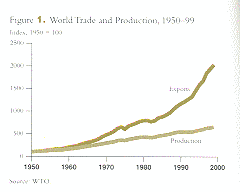 Today the total value of annual international exports is almost $7 trillion. For the United States, total trade (exports and imports) has increased from 11 percent of GDP in 1929 to today’s 25 percent, but all that growth has come about in the past quarter century.
Today the total value of annual international exports is almost $7 trillion. For the United States, total trade (exports and imports) has increased from 11 percent of GDP in 1929 to today’s 25 percent, but all that growth has come about in the past quarter century.
Global capital markets have also grown rapidly, with private capital flows rising from less than 5 percent of world GDP in 1975 to about 20 percent today. And foreigners play a critical role in financing the U.S. economy. At the end of 2000, Americans, with a national income of $8 trillion, had investments in the rest of the world worth about $3.7 trillion, while foreign claims on the United States totaled $7.4 trillion.
And while the share of the global population migrating across national borders has remained roughly stable over the past half century, its composition has changed: a growing proportion moves from very poor to rich countries. In the United States, the share of the population that is foreign-born has increased dramatically in the past 40 years, though it remains below that of the early 1900s (see figure 2).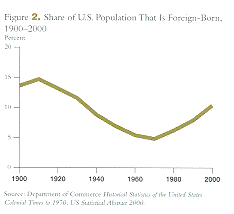
Finally, the falling cost of travel, as well as technological innovations in communications, has greatly increased contact between people of disparate cultures. Today, some 250 million people worldwide have access to the Internet, putting them in touch with ideas and information from literally anywhere else in the world at any time. Global television and radio broadcasts and other media have also helped promote unprecedented contact among people of different nations. Those contacts have promoted extensive cultural interaction, offering people around the world the many benefits of access to different cultures, but have also stoked resentment in some quarters as people worry about apparent “threats” to their way of life, often equating “globalization” with “Americanization.”
Why is globalization so controversial—Concerns vary. First, within any country, the liberalization of trade creates both winners and losers. Although economists can demonstrate that the gains to the winners will exceed the losses—the benefits of increased specialization and economies of scale—some losses can be substantial. Within U.S. manufacturing, for example, workers whose jobs are displaced through trade will ultimately suffer reductions in annual income that average about 16 percent when they find new jobs. Most countries make only minimal efforts to compensate the losers. Such domestic conflicts have long been evident in the United States in the textile, steel, and automobile industries, but their importance increases as the pace of globalization accelerates. More generally, a more open, competitive global economy can be expected to harm the welfare of low-skilled workers in the industrialized countries.
Second, a substantial portion of the globe’s population has thus far failed to gain from globalization, and poverty remains a severe problem for many. More than a billion people, roughly a quarter of the world’s population, exist on less than $1 a day; and more than half the world’s people live on less than $2 a day. Critics charge that the gains from globalization are too sharply skewed toward the already prosperous industrial countries. Most economic analysis suggests that poor countries need to be more, not less, integrated with the global economy if they are to have access to the capital, technology, and infrastructure required to raise productivity and living standards. But some analysts object that the industrial countries are erecting ever more barriers to new entrants in the form of restrictions on the use of new technologies, as well as labor and environmental standards higher than those followed by the industrial countries at similar stages of development.
In the debate over the distribution of globalization’s benefits it is important to distinguish between the change in the distribution of income within and among countries. Before World War I, incomes in countries now considered industrialized—Europe, the United States, Canada, Australia, and Japan—tended to converge because of expanding trade and the mass migration of people out of Europe. Since World War II, a similar convergence can be traced in large part to reconstruction of war-damaged economies. Several Asian economies also moved out of the ranks of severe poverty to achieve standards of living comparable to those of the industrialized economies of Europe.
The record is more disappointing when more countries are included (see figure 3).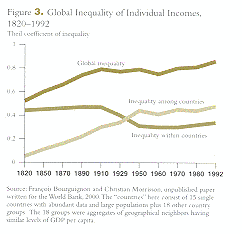 Over the span of a century or more, the income gap between the richest and poorest countries has widened. For the most recent decades, conclusions depend on specific methodologies and whether fast-growing economies, such as China, India, and Indonesia, are included. On balance, there has been little change in the aggregate, though some evidence suggests that significant involvement in the global trading system helps improve growth in the high performers.
Over the span of a century or more, the income gap between the richest and poorest countries has widened. For the most recent decades, conclusions depend on specific methodologies and whether fast-growing economies, such as China, India, and Indonesia, are included. On balance, there has been little change in the aggregate, though some evidence suggests that significant involvement in the global trading system helps improve growth in the high performers.
Third, environmental concerns have emerged as a new source of conflict. As shown in figure 4,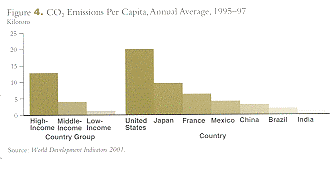 carbon emissions, believed to be a cause of global warming, are strongly tied to economic development. On a per capita basis Americans generate the most emissions—roughly seven times those of China. But the developing countries are helping to boost growth in emissions (figure 5)
carbon emissions, believed to be a cause of global warming, are strongly tied to economic development. On a per capita basis Americans generate the most emissions—roughly seven times those of China. But the developing countries are helping to boost growth in emissions (figure 5)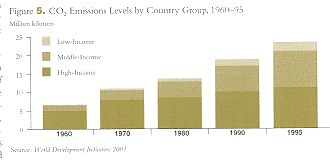 . The United States has refused to join in cooperative efforts to reduce carbon emissions unless constraints are placed on the developing countries, and it has rejected a standard that equalizes emissions per capita.
. The United States has refused to join in cooperative efforts to reduce carbon emissions unless constraints are placed on the developing countries, and it has rejected a standard that equalizes emissions per capita.
Other forms of pollution also rise with economic development, but as countries become wealthier they can afford to make the investments required to reduce pollution. Thus, some environmental problems will worsen with development, others will decline, and still others will initially worsen and then improve. Environmental quality becomes an important goal only in societies that have escaped grinding poverty. The transfer of pollution-control technologies from the rich to the poor nations also helps the poor countries achieve lower pollution goals than did the rich countries at comparable stages of development. It is sometimes argued that competition among countries to attract multinational firms and jobs might lead to a competitive race to the bottom in terms of environmental standards. The available evidence, however, suggests the opposite, as the more open economies have been quicker to adopt the cleaner technologies and foreign-owned firms tend to pollute less than national firms.
Finally, globalization is controversial because although open borders increase flows of less expensive and better-quality goods, well-allocated capital investments, and new ideas and information, they may also invite narcotics, laundered money, terrorists, weapons of mass destruction, and diseases like tuberculosis and AIDS. These less welcome consequences pose huge challenges to an international community more interconnected—and therefore more vulnerable to developments taking place all around the world—than ever before.
Can globalization be harnessed so that all citizens and countries benefit and not just the lucky few? Is it a force for spreading democracy and individual freedom, or does it help authoritarian governments to maintain control? Are global regimes and institutions—financial, commercial, environmental, and political—the best ways to cope with the challenges posed by globalization, or should each country fend primarily for itself? There are no easy answers, but these are some of the critical questions that our contributors address.



Commentary
Managing a Globalizing World: An Overview
September 1, 2001